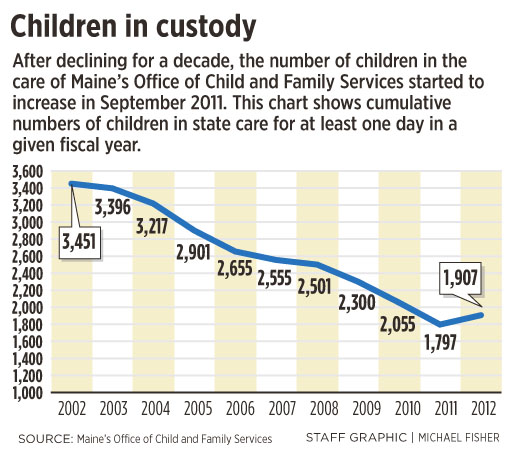The Portland Press Herald/Maine Sunday Telegram was hampered in gathering foster care spending and caseload information for this report because of the limited data collection practices and multiple computer systems at the Maine Department of Health and Human Services.
The newspaper initially asked for data for various categories of foster care dating back to 2000, hoping to identify trends that might explain the recent increase in children coming into the care of the Office of Child and Family Services. Categories include foster, special needs, pre-adoptive, kinship and congregate.
DHHS spokesman John Martins said it would take a state employee 24 hours, at a cost of $15 an hour, to fulfill the request under Maine’s Freedom of Information Act. If the agency attempted to tally the system’s annual Medicaid/MaineCare costs, it would take even longer, Martins said.
“The data you request spans 12-plus years, three commissioners, the merger that created DHHS, the formation of the Office of Child and Family Services and two different gubernatorial administrations,” Martins explained in an email. “I do know those complexities factor into the time request.”
The DHHS ultimately charged the newspaper $30, ostensibly to gather and provide information that Robert Blanchard, the office’s data chief, later said was readily available.
The office tallies monthly, point-in-time caseload and budget data for day-to-day case management purposes, but it generally doesn’t use that information to analyze foster care trends for long-term budget preparation, Blanchard said.
The office also produces annual, point-in-time counts in different care categories for the Maine Kids Count report that is produced by the Maine Children’s Alliance.
When the newspaper asked for cumulative budget and caseload data, it provided expenditure totals dating back to fiscal 2008, kinship and special needs caseload data to fiscal 2006 and overall caseload numbers to fiscal 2002.
Blanchard said the office occasionally reviews data for strategic planning purposes but generally is focused on month-to-month numbers to be able to provide optimum care with limited resources for families with ever-changing needs.
“The hard part is, you’re trying to describe a huge, cumbersome system,” Blanchard said. “It would be really easy if the kids were always the same, but they’re not. They’re always changing.”
– Staff Writer Kelley Bouchard
Send questions/comments to the editors.



Comments are no longer available on this story